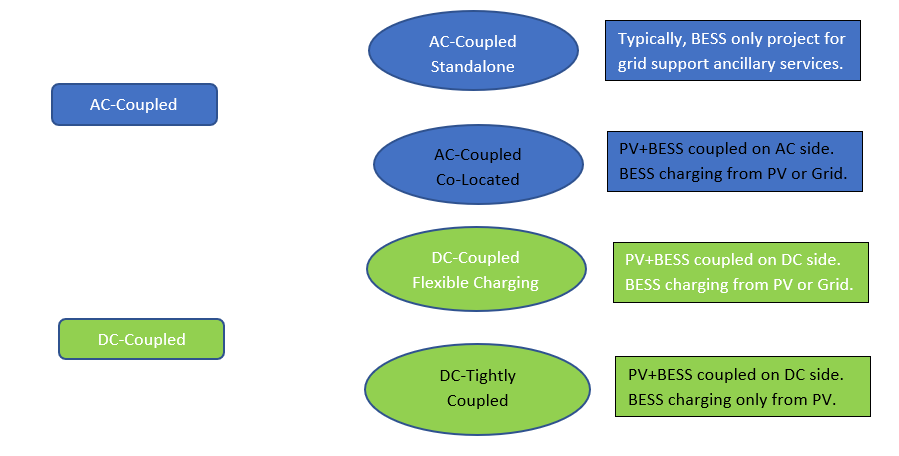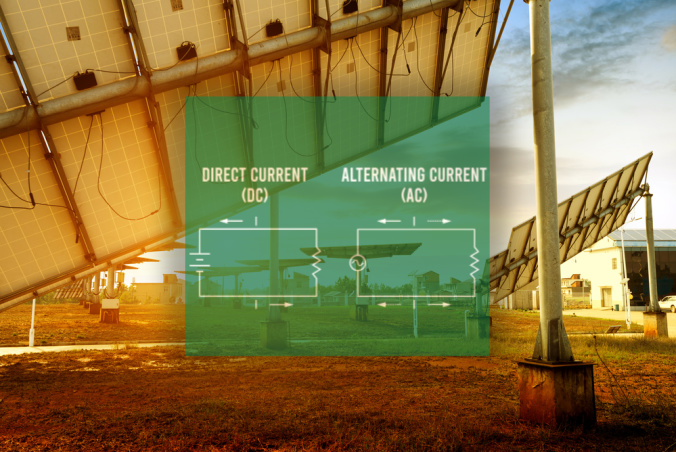Grid connected PV-Solar plants are non-dispatchable energy sources controlled to inject maximum available power into the power grid. Currently, they lack the control and regulation services of conventional sources due to their operating characteristics. This can impact the voltage and stability of the grid system. Integrating a battery energy storage system (BESS), into a large-scale PV-Solar power plant, enables a more flexible operation, allowing the plant to better support energy demand, and support grid stability more efficiently.
A lot of work is being done, regarding analyzing and comparing the performance of AC-Coupled and DC-Coupled solutions. One such report by National Renewable Energy Laboratory (NREL), evaluated the technical and economic performance of PV + BESS power plants.
Combining PV+BESS, wind, and other renewable technologies, such as hybrid plants, increases efficiencies in many desirable grid services. For plant developers, owners, and operators, these services can be stacked to provide multiple value streams such as:
- Energy shifting
- Capacity firming
- PV smoothing
- Frequency regulation
- Ramp rates
- Black start
The definition of plant performance requirements and identification of economic considerations are key to empowering optimal choices of resource types, technologies, and plant design.
PV+BESS plants can be built using different system configurations. Broadly, there are two main configurations used, namely AC-Coupled and DC-Coupled. These can be classified into:

In the AC-Coupled configuration, the BESS is connected to the AC-side of the system via an additional inverter. In the DC-Coupled systems, configuration of the BESS is connected to the DC-side, with or without a DC-DC converter, and no additional inverter is required.
Advantages and disadvantages for AC-Coupled vs DC-Coupled are tightly debated. Here are some important considerations:
The AC coupled integration of storage into an existing PV-Solar plant is relatively simple as the storage equipment can be placed adjacent to the solar collection substation with little impact to solar operations. This allows for charging from the entire solar array to qualify for ITC. Advantages offered by AC-Coupled plant are:
Easy retrofits to existing PV-Solar plants.
Can participate in the market as two separate resources.
The capability to capture AC Solar clipping and ISO driven curtailments.
More streamlined BESS augmentation.
The disadvantages of an AC Coupled system is that they cannot capture DC Solar clipping or additional inverters required for BESS, as it operates as two independent plants.
The DC-coupled integration of storage into existing PV-Solar plants is more complex, as space must be available and in close proximity to each solar inverter to place the battery equipment. In this configuration, the Solar array and battery storage systems are connected at the DC side of the inverter, which can capture the DC clipped energy. Advantages of the DC-Coupled plant can offer are:
Access to all clipped energy.
Savings on pad-mount and collection system costs.
Higher round trip efficiency.
Some of the disadvantages of a DC-coupled system would include requirements of batteries to be located closer to solar arrays and not at the substation, which can make it difficult to retrofit existing PV-Solar plants and future BESS augmentation.
Various factors that can influence the decision of having AC Vs DC coupling systems are:
For a new construction of a PV+BESS plant, the decision may go in favor of the DC-Coupled system since it can help with cost reduction via sharing the inverters.
- Although this can reduce clipping, it can result in non-optimal storage dispatch, especially if the storage capacity is sized close to the size of the inverter.
- In the case of DC-Tightly Coupled, or charging directly from PV-Solar only, can result in a significant loss of value. However, since this loss is currently the value of the 30% ITC, this configuration currently provides the highest benefit to cost ratio.
For existing PV-Solar plants, AC-Coupling makes more sense, in most cases. By co-locating PV + BESS, this will help decrease the overall net costs of deployment.
Solar Industry Magazine published an article on comparing AC and DC coupling in large-scale systems, stating that it is hard to ignore the substantial “head start” that AC coupling has such as:
- Solar-plus-storage projects that employ AC coupling tap inverter technology that is similar to solar and wind inverters.
- Design flexibility is a key consideration for large projects combining PV and storage. With AC coupled systems, it is straightforward to adjust the PV and storage ratios.
- Reduced costs with an increase in efficiency, reliability, and design flexibility.
In AC coupling, the inverter directly converts DC to AC. These inverters are single stage, and separate inverters are used for batteries and PV. The batteries are connected via bi-directional inverters with full four-quadrant capability. These bi-directional inverters are single stage and, therefore, also very efficient.
DC coupling requires a different approach and applies a dramatically different inverter topology. With DC coupling, the DC sources are coupled together. However, in practice this is more complicated and even potentially dangerous. When combining PV and batteries, installers must take care to never directly combine the DC buses.
PV voltage is regulated by a maximum power point tracking algorithm and changes throughout the day based on irradiance levels and module temperature.
On the other hand, battery voltage is regulated based on state of charge. Perhaps more importantly, batteries both accept power and provide power, while PV panels only provide power.
Erroneous attempts to “charge” a PV array, and similarly applying the incorrect DC voltage to a battery, can result in danger and damage to the system. Due to these issues, separate DC/DC converters are used on different DC sources, for proper voltage regulation and the electrical isolation needed by the PV array and the batteries. Inverters with more than one port used for more than one DC input is called a “multi-port” inverter. They are also known as multi-stage inverters as the ports require isolation. This concept refers to the power that is processed multiple times before an output AC waveform is provided. When power is processed twice, there are even greater losses. This directly results in lower efficiency, which results in greater heat generation in the converter, along with greater component stress and higher failure rates.
There isn’t a straightforward answer between choosing an AC-Coupled or DC-Coupled system. It will largely be dependent on the status of the plant, whether it is a new construction or an existing PV-Solar plant. In addition to electrical integration, market participation models, revenue, metering designs, and affiliate agreements may also need to be considered. Expected participation of plants in various functions and services will utilize capabilities like grid forming technology, operation in low short-circuit networks, the ability to provide primary and fast frequency response (FFR), Energy Time Shifting (Arbitrage), and other functions that help improve efficiency, reliability, resilience, to the stability of the power grid.
Nor-Cal Controls offer custom SCADA, DAS, and MET solutions for your PV + Storage projects. Let’s discuss options for your existing or upcoming projects. Schedule a call with us today.



.png?width=675&name=image%20(8).png)

